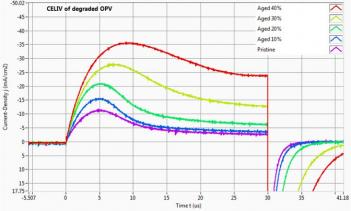Fluxim released a new version (3.4) of its setfos simulation software used to study OLEDs and OPVs. The new version 3.4 is a major improvement with respect to drift-diffusion modeling and light-outcoupling simulation. Some of the major improvements are:
- Modeling of electrical impedance spectra in the presence of charge traps
- Improved convergence for the steady-state drift-diffusion solver
- Improved heterojunction interface model
- Light extraction from arbitrary stacks of coherent and incoherent layers

For the first time, mixed coherent and incoherent layers can be considered which is especially useful to simulate the effect of color filters in OLED applications. Extended small signals analysis features have been included such as the effect of photogenerated charges or single level charge trapping. This allows even a better insight into the dynamic behavior of OLEDs and OPVs.
Simultaneously, Fluxim has also released paios 1.3, the all-in-one measurement platform to characterize solar cells and OLEDs. The system is now capable to study systematically the degradation of organic solar cells and OLEDs.
The device is electrically and/or optically stressed and fully characterized periodically. The combination of various techniques (JV, transient photocurrent, dark-CELIV, photo-CELIV, DIT, TEL, IS, CV, etc.) allows to draw valuable conclusions about the aging mechanisms.
For more information, please visit www.fluxim.com.
This is a sponsored post from Fluxim (an OLED-Info sponsor)

